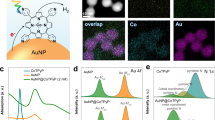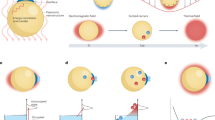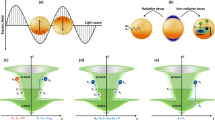Abstract
The field of heterogeneous photocatalysis has almost exclusively focused on semiconductor photocatalysts. Herein, we show that plasmonic metallic nanostructures represent a new family of photocatalysts. We demonstrate that these photocatalysts exhibit fundamentally different behaviour compared with semiconductors. First, we show that photocatalytic reaction rates on excited plasmonic metallic nanostructures exhibit a super-linear power law dependence on light intensity (rate ∝intensityn, with n > 1), at significantly lower intensity than required for super-linear behaviour on extended metal surfaces. We also demonstrate that, in sharp contrast to semiconductor photocatalysts, photocatalytic quantum efficiencies on plasmonic metallic nanostructures increase with light intensity and operating temperature. These unique characteristics of plasmonic metallic nanostructures suggest that this new family of photocatalysts could prove useful for many heterogeneous catalytic processes that cannot be activated using conventional thermal processes on metals or photocatalytic processes on semiconductors.
This is a preview of subscription content, access via your institution
Access options
Subscribe to this journal
Receive 12 print issues and online access
$259.00 per year
only $21.58 per issue
Buy this article
- Purchase on Springer Link
- Instant access to full article PDF
Prices may be subject to local taxes which are calculated during checkout




Similar content being viewed by others
References
Fujishima, A. & Honda, K. Electrochemical photolysis of water at a semiconductor electrode. Nature 238, 37–38 (1972).
Linsebiger, A. L., Lu, G. & Yates, J. T. Photocatalysis on TiO2 surfaces: Principles, mechanisms, and selected results. Chem. Rev. 95, 735–758 (1995).
Kudo, A. & Miseki, Y. Heterogeneous photocatalyst materials for water splitting. Chem. Soc. Rev. 38, 253–278 (2009).
Asahi, R., Morikawa, T., Aoki, K. & Taga, Y. Visible-light photocatalysis in nitrogen-doped titanium oxides. Science 293, 269–271 (2001).
Hou, Y. et al. Bioinspired molecular co-catalysts bonded to a silicon photocathode for solar hydrogen evolution. Nature Mater. 10, 434–438 (2011).
Christopher, P., Ingram, D. B. & Linic, S. Enhancing photochemical activity of semiconductor nanoparticles with optically active Ag nanostructures: Photochemistry mediated by Ag surface plasmons. J. Phys. Chem. C 114, 9173–9177 (2010).
Ingram, D. B. & Linic, S. Water splitting on composite plasmonic-meta/semiconductor photoelectrodes: Evidence for selective plasmon-induced formation of charge carriers near the semiconductor surface. J. Am. Chem. Soc. 133, 5202–5205 (2011).
Mallouk, T. E. The emerging technology of solar fuels. J. Phys. Chem. Lett. 1, 2738–2739 (2010).
Linic, S., Christopher, P. & Ingram, D. B. Plasmonic-metal nanostructures for efficient conversion of solar to chemical energy. Nature Mater. 10, 911–921 (2011).
Christopher, P., Xin, H. & Linic, S. Visible light enhanced catalytic oxidation reactions on plasmonic Ag nanostructures. Nature Chem. 3, 467–472 (2011).
Busch, D. G. & Ho, W. Direct observation of the crossover from single to multiple excitations in femtosecond surface photochemistry. Phys. Rev. Lett. 77, 1338–1341 (1996).
Thompson, T. L. & Yates, J. T. Jr Monitoring hole trapping in photoexcited TiO2(110) using a surface photoreaction. J. Phys. Chem B 109, 18230–18236 (2010).
Westrich, T. A., Dahlberg, K. A., Kaviany, M. & Schwank, J. W. High-temperature photocatalytic ethylene oxidation over TiO2 . J. Phys. Chem. C 115, 16537–16543 (2011).
Linic, S. & Barteau, M. A. Control of ethylene epoxidation selectivity by surface oxametallacycles. J. Am. Chem. Soc. 125, 4034–4035 (2003).
Brus, L. Noble metal nanocrystals: Plasmon electron transfer photochemistry and single-molecule Raman spectroscopy. Acc. Chem. Res. 41, 1742–1749 (2008).
El-Sayed, M. A. Some Interesting properties of metals confined in time and nanometer space of different shapes. Acc. Chem. Res. 34, 257–264 (2001).
Kelly, K. L., Coronado, E., Zhao, L. L. & Schatz, G. C. The optical properties of metal nanoparticles: The influence of size, shape, and dielectric environment. J. Phys. Chem. B 107, 668–677 (2003).
Gunnarsson, L. et al. Confined plasmons in nanofabricated single silver particle pairs: Experimental observations of strong interparticle interactions. J. Phys. Chem. B 109, 1079–1087 (2005).
Kamat, P. V. Photophysical, photochemical and photocatalytic aspects of metal nanoparticles. J. Phys. Chem. B 106, 7729–7744 (2002).
Jain, P. K., Huang, X., El-Sayed, I. H. & El-Sayed, M. A. Noble metals on the nanoscale: Optical and photothermal properties and some applications in imaging, sensing, biology, and medicine. Acc. Chem. Res. 41, 1578–1586 (2008).
Nie, S. & Emory, S. R. Probing single molecules and single nanoparticles by surface-enhanced Raman scattering. Science 275, 1102–1106 (1997).
Kühn, S., Håkanson, U., Rogobete, L. & Sandoghdar, V. Enhancement of single-molecule fluorescence using a gold nanoparticle as an optical nanoantenna. Phys. Rev. Lett. 97, 017402 (2006).
Moskovitz, M. Surface-enhanced Raman spectroscopy: A brief retrospective. J. Raman Spectrosc. 36, 485–496 (2005).
Monnier, J. R., Medlin, J. W. & Barteau, M. A. Use of oxygen-18 to determine kinetics of butadiene epoxidation over Cs-promoted, Ag catalysts. J. Catal. 203, 362–368 (2001).
Bonn, M. et al. Phonon-versus electron-mediated desorption and oxidation of CO on Ru(0001). Science 285, 1042–1045 (1999).
Hatch, S. R., Zhu, X-Y., White, J. M. & Campion, A. Photoinduced pathways to dissociation and desorption of dioxygen on Ag(110) and Pt(111). J. Phys. Chem. 95, 1759–1768 (1991).
So, S. K., Franchy, R. & Ho, W. Photodesorption of NO from Ag(111) and Cu(111). J. Chem. Phys. 95, 1385–1399 (1991).
Dai, H-L. & Ho, W. Laser Spectroscopy and Photochemistry on Metal Surfaces (World Scientific, 1995).
Gadzuk, J. W. Hot-electron femtochemistry at surfaces: On the role of multiple electron processes in desorption. Chem. Phys. 251, 87–97 (2000).
Mulugeta, D., Kim, K. H., Watanabe, K., Menzel, D. & Freund, H-J. Size effects in thermal and photochemistry of (NO)2 on Ag nanoparticles. Phys. Rev. Lett. 101, 146103 (2008).
Kim, K. H., Watanabe, K., Mulugeta, D., Freund, H-J. & Menzel, D. Enhanced photoinduced desorption from metal nanoparticles by photoexcitation of confined hot electrons using femtosecond laser pulses. Phys. Rev. Lett. 107, 047401 (2011).
Beckerle, J. D. et al. Ultrafast infrared response of adsorbates on metal surfaces: Vibrational lifetime of CO/Pt(111). Phys. Rev. Lett. 64, 2090–2093 (1990).
Bartels, L. et al. Dynamics of electron-induced manipulation of individual CO molecules on Cu(111). Phys. Rev. Lett. 80, 2004–2007 (1998).
Olsen, T., Gavnholt, J. & Schiøtz, J. Hot-electron-mediated desorption rates calculated from excited-state potential energy surfaces. Phys. Rev. B 79, 035403 (2009).
Gavnholt, J., Olsen, T., Engelund, M. & Schiøtz, J. Δ Self-consistent field method to obtain potential energy surfaces of excited molecules on surfaces. Phys. Rev. B 78, 075441 (2008).
Wingreen, N. S., Jacobsen, K. W. & Wilkins, J. W. Inelastic scattering in resonant tunneling. Phys. Rev. B 40, 11834–11850 (1989).
Ho, W. Reactions at metal surfaces induced by femtosecond lasers, tunneling electrons and heating. J. Phys. Chem. 100, 13050–13060 (1996).
Olsen, T. & Schiøtz, J. Origin of power laws doe reactions at metal surfaces mediated by hot electrons. Phys. Rev. Lett. 103, 238301 (2009).
Madey, T. E., Yates, J. T., King, D. A. & Uhlaner, C. J. Isotope effect in electron stimulated desorption: Oxygen chemisorbed on tungsten. J. Chem. Phys. 52, 5215–5220 (1970).
Grillet, N. et al. Plasmon coupling in silver nanocube dimers: Resonance splitting induced by edge rounding. ACS Nano. 5, 9450–9462 (2011).
Persson, B. N. J. On the theory of surface-enhanced Raman spectroscopy. Chem. Phys. Lett. 82, 561–565 (1981).
Michaels, A. M., Jiang, J. & Brus, L. Ag nanocrystal junctions as the site for surface-enhanced Raman scattering of single rhodamine 6G molecules. J. Phys. Chem. B 104, 11965–11971 (2000).
Watanabe, K., Menzel, D., Nilius, N. & Freund, H. J. Photochemistry on metal nanoparticles. Chem. Rev. 106, 4301–4320 (2006).
Kim, K. H. et al. Enhanced photoinduced desorption from metal nanoparticles by photoexcitation of confined hot electrons using femtosecond laser pulses. Phys. Rev. Lett. 107, 047401 (2011).
Kawazoe, T. et al. Nonadiabatic photodissociation process using an optical near field. J. Chem. Phys. 122, 024715 (2005).
Christopher, P. & Linic, S. Shape- and size-specific chemistry of Ag nanostructures in catalytic ethylene epoxidation. Chem. Catal. Chem. 2, 78–83 (2010).
Christopher, P. & Linic, S. Engineering selectivity in heterogeneous catalysis: Ag nanowires as selective ethylene epoxiation catalysts. J. Am. Chem. Soc. 130, 11264–11265 (2008).
Enkovaara, J. et al. Electronic structure calculations with GPAW: A real-space implementation of the projector augmented wave method. J. Phys. Condens. Matter 22, 253202 (2010).
Hammer, B., Hansen, L. & Nørskov, J. Improved adsorption energetics within density-functional theory using revised Perdew-Burke-Ernzerhof functionals. Phys. Rev. B 59, 7413–7421 (1999).
Buatier de Mongeot, F., Cupolillo, A., Valbusa, U. & Rocca, M. Anharmonicity of the O2-Ag(001) chemisorption. J. Chem. Phys. 106, 9297–9304 (1997).
Acknowledgements
We gratefully acknowledge support from United States Department of Energy, Office of Basic Energy Science, Division of Chemical Sciences (FG-02-05ER15686) and the National Science Foundation (CBET-0966700, CBET-1132777 and CHE-1111770). S.L. acknowledges the DuPont Young Professor grant and the Camille Dreyfus Teacher-Scholar Award from the Camille Henry Dreyfus Foundation. We also acknowledge David B. Ingram for assistance with FDTD simulations.
Author information
Authors and Affiliations
Contributions
P.C., H.X., and S.L. developed the project and analysed the results. P.C. carried out experimental work. H.X. performed the DFT simulations. A.M. assisted with analysis. S.L. is the PhD adviser of P.C., H.X. and A.M.
Corresponding author
Ethics declarations
Competing interests
The authors declare no competing financial interests.
Supplementary information
Supplementary Information
Supplementary Information (PDF 993 kb)
Rights and permissions
About this article
Cite this article
Christopher, P., Xin, H., Marimuthu, A. et al. Singular characteristics and unique chemical bond activation mechanisms of photocatalytic reactions on plasmonic nanostructures. Nature Mater 11, 1044–1050 (2012). https://doi.org/10.1038/nmat3454
Received:
Accepted:
Published:
Issue Date:
DOI: https://doi.org/10.1038/nmat3454
This article is cited by
-
Pt-doped Ru nanoparticles loaded on ‘black gold’ plasmonic nanoreactors as air stable reduction catalysts
Nature Communications (2024)
-
Plasmon-mediated chemical reactions
Nature Reviews Methods Primers (2023)
-
Surface plasmon-enhanced photo-driven CO2 hydrogenation by hydroxy-terminated nickel nitride nanosheets
Nature Communications (2023)
-
Near-infrared-featured broadband CO2 reduction with water to hydrocarbons by surface plasmon
Nature Communications (2023)
-
Achieving maximum overall light enhancement in plasmonic catalysis by combining thermal and non-thermal effects
Nature Catalysis (2023)



